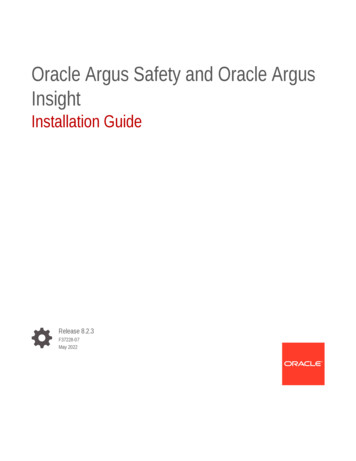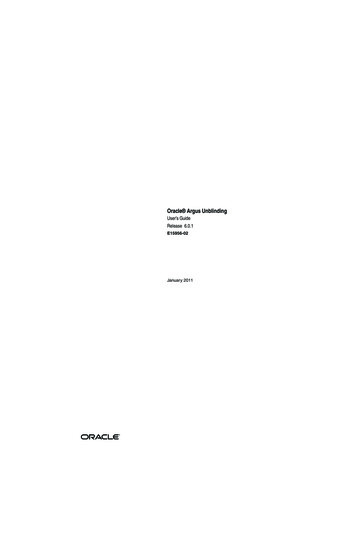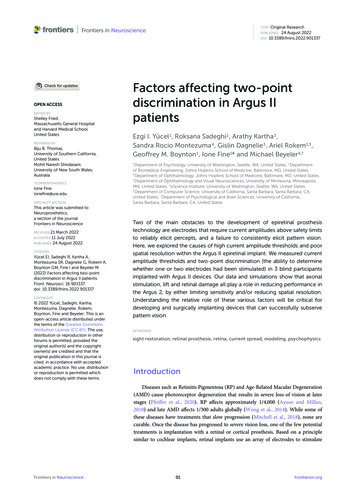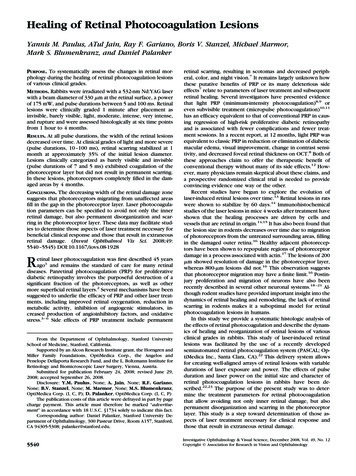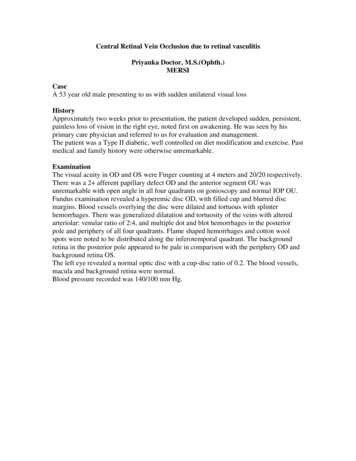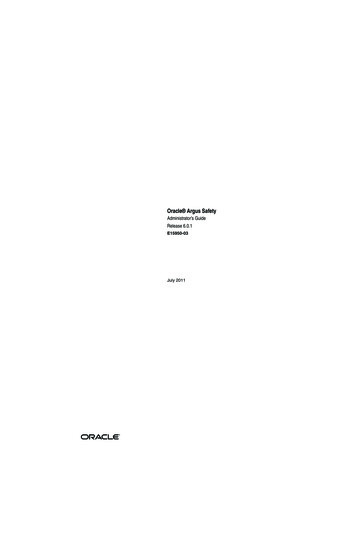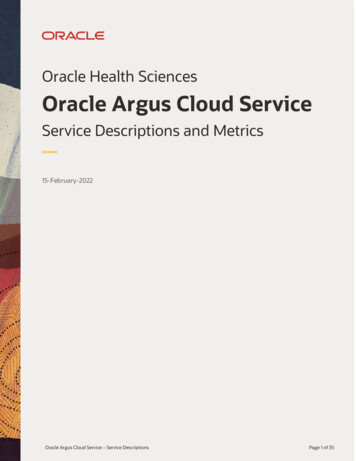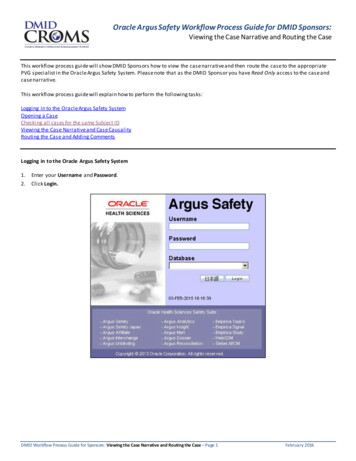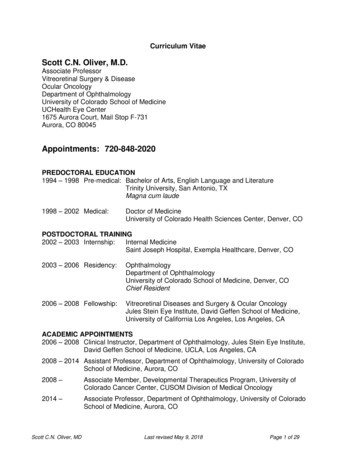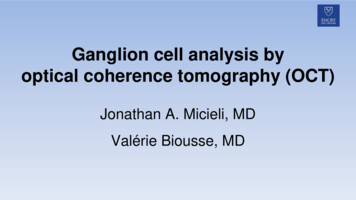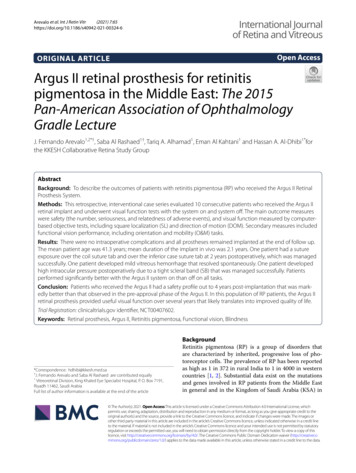
Transcription
(2021) 7:65Arevalo et al. Int J Retin INAL ARTICLEInternational Journalof Retina and VitreousOpen AccessArgus II retinal prosthesis for retinitispigmentosa in the Middle East: The 2015Pan‑American Association of OphthalmologyGradle LectureJ. Fernando Arevalo1,2*†, Saba Al Rashaed1†, Tariq A. Alhamad1, Eman Al Kahtani1 and Hassan A. Al‑Dhibi1*forthe KKESH Collaborative Retina Study GroupAbstractBackground: To describe the outcomes of patients with retinitis pigmentosa (RP) who received the Argus II RetinalProsthesis System.Methods: This retrospective, interventional case series evaluated 10 consecutive patients who received the Argus IIretinal implant and underwent visual function tests with the system on and system off. The main outcome measureswere safety (the number, seriousness, and relatedness of adverse events), and visual function measured by computerbased objective tests, including square localization (SL) and direction of motion (DOM). Secondary measures includedfunctional vision performance, including orientation and mobility (O&M) tasks.Results: There were no intraoperative complications and all prostheses remained implanted at the end of follow up.The mean patient age was 41.3 years; mean duration of the implant in vivo was 2.1 years. One patient had a sutureexposure over the coil suture tab and over the inferior case suture tab at 2 years postoperatively, which was managedsuccessfully. One patient developed mild vitreous hemorrhage that resolved spontaneously. One patient developedhigh intraocular pressure postoperatively due to a tight scleral band (SB) that was managed successfully. Patientsperformed significantly better with the Argus II system on than off on all tasks.Conclusion: Patients who received the Argus II had a safety profile out to 4 years post-implantation that was mark‑edly better than that observed in the pre-approval phase of the Argus II. In this population of RP patients, the Argus IIretinal prosthesis provided useful visual function over several years that likely translates into improved quality of life.Trial Registration: clinicaltrials.gov identifier, NCT00407602.Keywords: Retinal prosthesis, Argus II, Retinitis pigmentosa, Functional vision, Blindness*Correspondence: hdhibi@kkesh.med.sa†J. Fernando Arevalo and Saba Al Rashaed are contributed equally1Vitreoretinal Division, King Khaled Eye Specialist Hospital, P. O. Box 7191,Riyadh 11462, Saudi ArabiaFull list of author information is available at the end of the articleBackgroundRetinitis pigmentosa (RP) is a group of disorders thatare characterized by inherited, progressive loss of photoreceptor cells. The prevalence of RP has been reportedas high as 1 in 372 in rural India to 1 in 4000 in westerncountries [1, 2]. Substantial data exist on the mutationsand genes involved in RP patients from the Middle Eastin general and in the Kingdom of Saudi Arabia (KSA) in The Author(s) 2021. Open Access This article is licensed under a Creative Commons Attribution 4.0 International License, whichpermits use, sharing, adaptation, distribution and reproduction in any medium or format, as long as you give appropriate credit to theoriginal author(s) and the source, provide a link to the Creative Commons licence, and indicate if changes were made. The images orother third party material in this article are included in the article’s Creative Commons licence, unless indicated otherwise in a credit lineto the material. If material is not included in the article’s Creative Commons licence and your intended use is not permitted by statutoryregulation or exceeds the permitted use, you will need to obtain permission directly from the copyright holder. To view a copy of thislicence, visit http:// creat iveco mmons. org/ licen ses/ by/4. 0/. The Creative Commons Public Domain Dedication waiver (http:// creat iveco mmons. org/ publi cdoma in/ zero/1. 0/) applies to the data made available in this article, unless otherwise stated in a credit line to the data.
Arevalo et al. Int J Retin Vitr(2021) 7:65particular [3]. However, there are no epidemiologic studies reporting the prevalence of RP. The high rate of consanguineous marriages and significant number of paperspublished on mutation analysis in KSA suggest a relatively high prevalence of RP [4].A significant number of clinical trials have investigateddifferent approaches to manage this condition includinggene therapy, stem cell transplantation and electronicneural prostheses in different locations in the eye [5–9].The numerous management approaches indicate thelack of a definitive treatment for RP. However, the onlytreatment that is approved by the United States Foodand Drug Administration (since February 2013) is theArgus II Retinal Prosthesis System (Second Sight MedicalProducts [SSMP], Inc., Sylmar, CA, USA). This prosthesis is a surgically implantable epiretinal device designedto provide artificial vision to patients with outer retinaldegenerative disease with viable inner retinal cells andnerve fiber layer such as RP. Since June 2007, over 350devices have been implanted at 25 centers in 12 countriesworldwide. this number is unlikely to increase followingSSMP’s announcement that the production of the ArgusII Retinal Prosthesis System has been suspended in orderto focus on optimizing the development of the OrionCortical Prosthesis System (Second Sight Medical Products Inc., Sylmar, CA, USA).The Argus II feasibility multicenter study (clinicaltrials.gov identifier, NCT00407602) in US and Europe enrolledthirty patients who underwent prosthesis implantationand were followed for 10 years postoperatively [10, 11].A study on these 30 patients by da Cruz et al. reportedthe safety and performance of this study at 5 years postimplantation [12]. Patients performed significantly betterwith the Argus II system on than off on all visual functiontests and functional vision tasks [12]. These results support the long-term safety profile and benefit of the ArgusII system for patients who are blind due to RP. In SaudiArabia, the Argus II system received limited approval[restricted to the King Khaled Eye Specialist Hospital(KKESH), Riyadh, Saudi Arabia] in June 2012 and fullapproval was received in June 2015.The current study presents the functional and anatomic outcomes in 10 patients with RP that received theArgus II Retinal Prosthesis System at KKESH from 2013to 2016.Material and methodsThis retrospective consecutive interventional case seriesevaluated 10 patients (10 eyes) diagnosed with retinitispigmentosa who underwent implantation of Argus II retinal prosthesis system from February 2013 to August 2016at KKESH. Patients were referred from other centerswithin Saudi Arabia and some patients were self-referred.Page 2 of 11The KKESH Institutional Review Board (IRB)/EthicsCommittee approval was obtained and patients signedan informed consent for this study. This study adheredto the tenets of the Declaration of Helsinki for researchinvolving human subjects.The Argus II retinal prosthesis systemThe external component of the Argus II consists of aglasses-mounted camera and a battery-powered videoprocessing unit that is worn on the patient’s body. Theprocessing unit converts the camera-captured imageinto an electronic signal that is transmitted by cable to atransmitting coil located on the glasses. The implantedportion of the device (Fig. 1) consists of a receiving coiland an electronics capsule that wirelessly receives information from an external transmitting coil and is suturedto the sclera by an encircling scleral band. Data are sentvia a small transscleral cable from the electronics capsuleto the electrode array, which is firmly held to the retinal surface by a retinal tack. The array is a 6 10 grid ofelectrodes, with each electrode emitting electric pulsesdirectly to the retinal surface. Direct retinal electric stimulation of the bipolar cells in the inner retina are thentransmitted via the optic nerve to the visual cortex. Thisallows the patient to perceive spots of light. The maximum visual field obtained with the Argus II System isapproximately 20 .Patient populationInclusion criteria: patient age of at least 25 years, bareor no light perception [visual acuity worse than 2.9 logarithm of the minimum angle of resolution (logMAR)] inboth eyes, a history of useful form vision, axial lengthbetween 21 and 26 mm, educated literate patients with atleast high school education, a healthy, functioning opticnerve based on response to light.Exclusion criteria: a physical condition that precludedprosthesis implantation, concurrent complicating ocularpathology, axial length less than 21 mm or longer than26 mm, mental retardation or illiterate subjects.Data were collected on patient demographics, ophthalmic examination, fundus photography, fluoresceinangiography, optical coherence tomography (OCT)(Spectralis Heidelberg Retinal Angiography OCT, Heidelberg Engineering, Heidelberg, Germany), and axiallength measurement using ultrasonography. Data collected on preoperative and postoperative visual functiontests included: the square localization (SL) test, directionof motion (DOM) test, grating visual acuity (GVA) test,and orientation and mobility (O&M) tasks. Intraoperative and postoperative complications were also recorded.
Arevalo et al. Int J Retin Vitr(2021) 7:65Page 3 of 11Fig. 1 Photographs of the Argus II Retinal Prosthesis System (Second Sight Medical Products, Inc, Sylmar, CA). A the implanted components of thesystem and B the external (body-worn) components of the systemPreoperative examinations and visual function testsThe SL test measures a patient’s ability to localize a whitesquare on a black touch-screen monitor [10–12]. Thesize of the square (7.3 cm) and the contrast betweenthe square and the computer screen (100%) do not vary,however, the location of the square on the computerscreen changes. After positioning the patient 30.5 cmaway from the screen, head scanning was used to localize the square on the screen. The subject was then askedto touch the middle of the white square and this processwas repeated 40 times. The average difference betweenthe center of the square and where the patient touchedthe screen (in cm), was automatically computed by thetesting software. The DOM test measures a patient’sability to detect motion. In this test, a white bar movesacross a black computer screen [10–12]. The size (3.7 cmwide); contrast (100%); and speed (2000 ms screen crossing time) of the stimulus remains constant, but the direction of motion varies. The subject was asked to indicatethe direction of motion on a touch-screen. Eighty trialswere performed and the average difference between thestimulus angle and the response angle was automaticallycomputed by the testing software.Postoperative examinations and testingFollow-up visits were performed at 1 day, 1 week, and 1,3, 6 and 12 months after surgery. At each follow-up visit,patients underwent a complete ophthalmic examination and a visual rehabilitation session was started at the1-month postoperative visit. Optical coherence tomography (OCT) images were obtained at 1 month postoperatively to verify proper device positioning. Once thedevice was implanted, the video processing unit was individually calibrated for each patient. This was done using aspecial computer program that measured the perceptionthreshold of each electrode and created a video configuration file. SL and DOM testing was performed at eachpostoperative visit beginning at 1 month postoperatively
Arevalo et al. Int J Retin Vitr(2021) 7:65onwards with both eyes open and the device switched on.Grating visual acuity was tested only in the operative eyewith the device switched on, patient mobility was testedbeginning at 1 month postoperatively onwards with orientation and mobility (O&M) tasks [10–12]. The taskconsisted of asking the subject to locate a bright light onthe corridor ceiling, find doors in a corridor, and to walkalong a dark line (30 cm wide) on the floor or a white lineon the pavement.Surgical technique for implantation of the Argus II retinalprosthesis systemTen patients underwent surgery by 4 different surgeons(JFA, SAR, EAK, HAD). The eye with the worse visualacuity was selected for surgery. Prior to surgery, 8 mg ofdexamethasone and 1000 mg of ceftriaxone were administered intravenously. Phakic patients underwent clearcorneal phacoemulsification of the lens 1 month beforeprosthesis implantation or pars plana lensectomy duringthe Argus II surgery.A 360 conjunctival peritomy was performed, and the4 rectus muscles were isolated. The prosthesis systemscleral band was passed under the 4 rectus muscles, theelectronics package is located in the upper temporalquadrant, the coil in the lower temporal quadrant. Thecoil and the scleral band were fixed to the sclera by passing a 5–0 nylon suture (Alcon Laboratories, Fort Worth,TX, USA) through suture tabs located on the device inthe temporal quadrants. In the nasal quadrants, the scleral band was fixed by 2 mattress sutures, and the scleralband was closed with a Watzke sleeve (FCI Ophthalmics Inc., San Francisco, CA, USA) in the upper nasalquadrant. A complete vitrectomy was performed usinga 23-gauge valved entry system, and the posterior hyaloid was removed. Triamcinolone acetonide was used forbetter visualization of the vitreous. If present, epiretinalmembranes were peeled. A further 5.2 mm wide sclerotomy parallel to the limbus was created in the superotemporal quadrant 3- 4.0 mm from the limbus, customizedfor each patient based on axial length. The sclerotomywas performed. The microelectrode array and cable werepassed through the sclerotomy, and the nasal sclerotomywas widened to accommodate the 19-gauge tacking forceps. The array was positioned over the macular regionwith a silicone brush flute needle or end-gripping forceps. A customized tack was placed in a ring locatedon the array and, perpendicular to the globe wall, thearray was tacked to the posterior pole superotemporalto the macula. Sclerotomies were closed with 7–0 vicryl(Ethicon, Somerville, New Jersey, USA), and a mattresssuture was placed over the external aspect of the cable.The extraocular segment of the cable was covered withTutopatch human pericardium or Tutopatch BovinePage 4 of 11Pericardium (RTI Surgical Inc. Alachua, FL, USA).Tenon’s capsule and conjunctiva were sutured with 7–0vicryl followed by intravitreal injection of vancomycin1 mg/0.1 ml and ceftazidime 2.25 mg/0.1 ml. Cefazolin(100 mg) dexamethasone (2 mg) and lidocaine 4% (2 mL)were injected subconjunctivally. Patients were prescribedoral ciprofloxacin (500 mg) twice-a-day for 2 weeks,beginning 2 days before surgery. Postoperative topicalmedications included moxifloxacin (1 drop, 4 times aday) dexamethasone (1 drop, 4 times a day) and atropine1% (1 drop, twice a day) for 2 weeks. Subjects took oralprednisolone (60 mg, once a day) for 2 weeks. Electrodeimpedance and waveform measurements were obtainedprior to surgery, after scleral band positioning, after retinal-array tacking, and at the end of surgery. These testswere performed to ensure that each of the 60 electrodeswas functioning properly before, during and after prosthesis implantation.The primary outcome measures were safety (thenumber, severity, and whether adverse events weredevice-related) and visual function, as measured by 2computer-based, objective tests, SL and DOM. Secondary measures included functional vision performance,including orientation and mobility (O&M) tasks.ResultsThe implantation surgery was uneventful in all cases. Atthe end of follow up, all 10 patients retained the prosthesis. Seven patients were male and the mean age ofthe study sample was 41.3 years (range, 26.0–55.0 years).The prosthesis was implanted in 6 right eyes and 4 lefteyes (Fig. 2; Table 1). Mean duration of follow-up was2.1 years, ranging from 4 months to 3.8 years. The visual acuity of all patients was no better than light perception. Preoperative monocular visual acuity was worsethan 2.9 logMAR in all patients. The mean axial lengthof the operative eyes was 23.96 mm (range, 22.76 mmto 25.83 mm). Six eyes were pseudophakic, 3 phakiceyes underwent pars plana lensectomy during prosthesis implantation surgery, and 1 eye had previous surgicalaphakia.Mean surgical time was 2 h and 52 min (range, 2–4 h7 min). Six patients had tight adherent posterior hyaloid and/or epiretinal membrane that required peeling.One patient had a preplaced scleral band and subretinalband at the macula and we had difficulties tacking theelectronic array due to irregularity of the retinal surface.Electrode channel damage occurred intraoperatively in 3patients; 2 patients had difficulty during retinal tacking(cases 2 and 6) and in 1 patient (case 1) it was possiblyrelated to exposure of the implant to a diathermy currentintraoperatively.
Arevalo et al. Int J Retin Vitr(2021) 7:65Page 5 of 11Fig. 2 Fundus photo of the prosthesis array and approximate foveal location (red dot). The electrode array is centered between the superior andinferior arcades. The distance from the fovea to the center of the array was 0.8 mmTable 1 Clinical data of the 10 patents implanted who received the Argus II systemPatient no EyeGender Age (years) Axiallength(mm)Lens StatusPeeling ofposteriorhyaloidPostoperative complications No. offunctioningelectrodesNo. ofrehabsessions1Right Male4524.96Pseudophakic YESConjunctival erosion5782Left5224.70AphakicElectrical Array Malposition47 7FemaleNO3Right Female2922.76Pseudophakic NONO5964Left4525.83Pseudophakic YESNO563Male5Right Male3823.75Pseudophakic NONO37*36Left5524.05Pseudophakic YESMild vitreous hemorrhage55†2Male7Right Male3324.20PhakicYESNO5858Left4722.76PhakicYESHigh IOP602Male9Right Female2623.74Pseudophakic NONO60010Right Male4322.90PhakicNO590NO loss of 10 electrodes channels during electronic array tacking*18 electrodes with high impedance value were observed at the end of the surgery. Electrode channels were damaged during the extra ocular placement of thedevice†After the tack insertion into the vitreous chamber, the surgeon observed that the tack was misaligned with the tack tool tip. When the surgeon removed it fromthe vitreous chamber, the tack dislodged from the tack tool and fell inside the vitreous cavity. The tack was managed as a foreign body and removal procedure wasperformedIOP Intraocular pressure, No. Number, mm millimeters, RE Right eye, LE Left eye, Gen GenderAnatomical outcome and postoperative complicationsDuring the 4 years follow-up period none of the patientshad any serious adverse events that required furthersurgery or required device explantation. There were nocases of retinal detachment or endophthalmitis. Theimplant was mispositioned in one patient (Case 2) due toa macular fold (Figs. 3 and 4). Postoperatively, this patientexperienced minor improvement in visual function.One patient (case 6) developed a mild vitreous hemorrhage postoperatively, likely secondary to intraoperative
Arevalo et al. Int J Retin Vitr(2021) 7:65Page 6 of 11Fig. 3 Fundus photo of the prosthesis array and approximate foveal location. The electrode array is superior to the fovea and slightly nasal to theoptic disk. The distance from the fovea to the center of the array was 2.8 mmFig. 4 Case 2 optical coherence tomography (OCT) did not show a subretinal band and retinal foldmanipulation caused by a dislodged tack. This complication resolved spontaneously after 2 weeks. One patientexperienced suture exposure over the coil suture tab andover the inferior case suture tab at 2 years postoperatively.This was managed by conjunctival suturing and pericardium patch graft placement. One patient experiencedhigh intraocular pressure postoperatively due to a tightscleral band which was remedied by relaxation of thescleral band. The intraocular pressure returned to normallimits without anti-glaucoma medications. PostoperativeOCT imaging showed that the array was well positionedin all patients (Fig. 5).
Arevalo et al. Int J Retin Vitr(2021) 7:65Page 7 of 11Fig. 5 Optical coherence tomography (OCT) demonstrating perfect apposition of the implant to the retinaVisual function and performance outcomesEight out of 10 patients performed significantly betterwith the Argus II system on than off on visual function tests and functional vision tasks. The mean error( SD) for SL was 8. 83 0.9 cm with the system onand 16.11 1.5 cm with the system off (Fig. 6) and thiswas statistically significant (p 0.001). The mean error( SD) for DOM across was 81.32 6.2 with the system on and 90.60 5.9 with the system off (P 0.05)(Table 2 and Fig. 7). Eight of 10 (80%) patients achievedFig. 6 The square localization (SL) test, which measures a patient’s ability to localize a white square on a black touch-screen monitor
Arevalo et al. Int J Retin Vitr(2021) 7:65Page 8 of 11visual function improvement as demonstrated by the SLresults and 4 of 10 (40%) patients experienced a largeimprovement in visual function. O&M outcomes wereobtained in the 10 patients (Table 3). These patientswere able to locate a bright light on the ceiling, avoid/detect obstacles, and all of these patients could detect aperson in front of them.Table 2 Visual function resultsPatient noDuration ofPre-Op visualimplantation (months) acuityPost-Op visual function test (number ofcorrect responses, out of 40 for SL and 80trials for DOM)SLDOMGVAPost-Op visualacuityComment147.0BLP24/4046/802.9 LogMARCFLarge improvement247.0BLP17/409/803.0 LogMARLPImprovement338.0LP23/4015/802.9 LogMARHMLarge improvement438.0BLP11/4037/802.9 LogMARCFLarge improvement538.0BLP11/4015/803.0 6/4021/803.0 LogMARImprovement89.0LP21/4034/802.9 LogMARLP CFLarge improvement95.0LP7/4021/803.0 LogMARLPStable105.0LP31/4027/803.0 LogMARLP ImprovementPerformance levels are the best out of 4 visitsNo. Number, Pre-op Preoperative, Post-op Postoperative, BLP Bare light perception, LP Light perception, LP Light perception and projection, HM Hand movements,CF Counting fingers, SL Square localization, DOM Direction of movement; GVA Grating of visual acuity, LogMAR logarithm of the minimum angle of resolution, NA NotavailableFig. 7 A direction-of-motion (DOM) test, which measures a patient’s ability to detect motion
Arevalo et al. Int J Retin Vitr(2021) 7:65Page 9 of 11Table 3 Rehabilitation outcomes with the system onPatient NoImplantDuration(months)Implanted OD89OS95OD105ODPerson detectionin front of patient Tracking/countingpeople in front ofpatient NA Avoid/detectobstacles in front ofpatient NAWalking byfollowing a lineand/or lights NANo. Number, NA Data not available, Able to achievePatients were not able to perform any of these tasks with the system offDiscussionIn this study, the implantation of the Argus II retinalprosthesis was safely performed in all patients. To date,none of patients have required an explantation of theprosthesis. The most common adverse events after ArgusII implantation include conjunctival erosion/dehiscence,hypotony, and endophthalmitis [13]. In our series, onlyone patient developed conjunctival erosion and was managed by suturing of the conjunctiva. A tight scleral band(SB) caused high intraocular pressure in one patient.The intraocular pressure returned to normal limits afterrelaxation of the SB. This complication has not been previously reported after Argus II implantation hence werecommend assessment of the SB tension before the endof surgery. One patient had mild vitreous hemorrhagethat resolved spontaneously without intervention.Electrode channel damage occurred intraoperatively in3 patients, two patients had difficulty during retinal tacking; one patient (case 2) had an irregular macular surfacecaused by a subretinal band and an adjacent fold that wasnot recognized before surgery. This patient had postoperative malposition of the electrical array. We elected toobserve this patient and there was some improvementof visual function and the O&M tests were improved.Another patient (case 6) had a dislodged retinal tackin the vitreous that was removed and a new tack wasplaced. This patient was lost to follow up but returnedat 4 months postoperatively, and his O&M performanceshowed some improvement. In the third patient (case 1)electrode channel damage occurred due to exposure todiathermy current that was used to cauterize episcleralbleeding. Hence, we do not recommend diathermy during the implant procedure. However, this patient had alarge gain in visual function tests, postoperatively.Patients performed significantly better with the ArgusII system on than with the system off on all visual function tests and functional vision tasks, and in 80% of cases,the visual function improved. Additionally, all patientswere able to use the device for daily-life conditions andto locate a bright light on the ceiling, detect obstacles,and in most cases, even detect a person in front of them.These results concur with previous studies Ahuja et al.and Dorn et al. report that touching the square or tracingwithin 15 from the true DOM is considered correct [11,13–15]. Hence, a binomial distribution can determinewhether the subjects performed above chance. For example, given the size of the square and the screen puts thelikelihood of touching the square by chance at (7.3/28.7)x (7.3/38.3) 0.0485, and the cut-off for an above-chanceperformance at 5 out of 40; touching the square 5 or moretimes in 40 trials by chance has a probability of 0.0453.For the DOM test, the likelihood of a correct responseby chance is (2 15/360) 0.0833, the required numberof correct responses is 12—tracing within 15 of the truedirection 12 or more times out of 80 has a probability of0.033. In other words, all subjects except #6 performedabove chance on the SL test, and all except #2 and #6 onthe DOM test.Patient selection, counseling for realistic patient expectations, and preoperative retinal assessment are crucialsteps for a successful outcome with Argus II implantation [16]. Case 2 in our series highlights these points.This patient had a small pupil with posterior synechia,which may have precluded an adequate preoperativeassessment. Our experience also indicates that initially,some of the patients did not adhere to the recommendedfollow up for visual rehabilitation sessions. Patientsgave several reasons related to lengthy commute to the
Arevalo et al. Int J Retin Vitr(2021) 7:65hospital, motivation, and high expectations. This issuewas addressed by inviting all the patients simultaneouslyto the hospital and allowing direct interaction with thesurgeons, Argus II experts, and rehabilitation specialists. After this meeting we noticed a dramatic increasein patient compliance to follow up and all the patientsseemed increasingly motivated to use the devise daily.There are some limitations to this study. The smallnumbers and retrospective nature of this study precluded in depth statistical analysis because additionaldata were unavailable. Hence the statistical power of thisstudy remains limited, and did not allow for a statisticaldifference in all visual function tests. A larger numberof patients would need to be studied with longer followup. In addition, we did not include a quality of life assessment questionnaire. In future prospective clinical trialsof artificial vision, a quality of life assessment questionnaire before and after the procedure would be desirable.However, our patients were satisfied with the results andfelt that the Argus II helped them to perform their visualtasks better and this is the first time this is has been demonstrated in a Middle Eastern population.ConclusionsIn conclusion, our results demonstrate the efficacy andsafety of the Argus II epiretinal prosthesis system, whichcan be an option to restore some vision in blind eyes withretinitis pigmentosa. Strict patient selection criteria arehighly recommended for excellent patient outcomes.AppendixThe following investigators belong to The King KhaledEye Specialist Hospital (KKESH) Collaborative RetinaStudy Group:The King Khaled Eye Specialist Hospital (KKESH):Marco Mura, MD (PI), Eman Al Kahtani, MD, SawsanNowilaty, MD, Saba Al Rashaed, MD, Hassan A. AlDhibi, MD, Yahya A Al-Zahrani, MD, Igor Kozak, MD,Sulaiman Al-Sulaiman, MD, Abdulelah Al-Abdullah,MD, Ahmad Al-Bar, MD, Yousef Al Dhafiri, MD, Abdullah Al Qahtani, MD, Khalid Al Rubaie, MD, Saeed AlShahrani, MD, Maha Al Shehri, MD, Badr Al Ahmadi,MD, Abdulaziz Al Hadlaq, MD, Majed Al Harbi, MD,Abdulaziz Al Oreany, MD.Wilmer Eye Institute, Retina Division, Johns HopkinsUniversity, Baltimore, MD, USA: J. Fernando Arevalo,MD, PhD, FACS (PI).AbbreviationsSL: Square localization; DOM: Direction of motion; O&M: Orientation andmobility tasks; RP: Retinitis pigmentosa; SB: Scleral band; KSA: Kingdom ofSaudi Arabia; SSMP: Second Sight Medical Products; KKESH: King Khaled EyePage 10 of 11Specialist Hospital; IRB: Institutional Review Board; logMAR: Logarithm of theminimum angle of resolution; OCT: Optical coherence tomography; GVA:Grating visual acuity.AcknowledgementsWe would like to acknowledge the KKESH research department and Mr.Abdulrahman AlHommadi for their efforts in the coordination of patient careon this project.Authors’ contributionsJFA, SAR, EAK, HAAD analyzed and interpreted data. JFA, TAA, HAAD weremajor contributors in writing the manuscript. All authors read and approvedthe final manuscript.FundingNone.Availability of data and materialsThe datasets generated and/or analyzed are available from the correspondingauthor on reasonable request.DeclarationsEthics approval and consent to participateThis study adhered to the tenets of the Declaration of Helsinki for researchinvolving human subjects. The KKESH Institutional Review Board (IRB)/EthicsCommittee
Argus II Retinal Prosthesis System (Second Sight Medical Products [SSMP], Inc., Sylmar, CA, USA). is prosthe-sis is a surgically implantable epiretinal device designed to provide articial vision to patients with outer retinal degenerative disease with viable inner retinal cells and nerve ber layer such as RP. Since June 2007, over 350
